Spotlight on sexually transmitted infections in the East of England: 2021 data
Updated 28 March 2024
Applies to England
Summary
Sexually transmitted infections (STIs) represent an important public health problem in the East of England. Out of all the UK Health Security Agency (UKHSA)’s regions, it had the second lowest rate of new STIs in England.
A total of 25,655 new STIs were diagnosed in East of England residents in 2021, representing a rate of 392 diagnoses per 100,000 population. Rates by upper tier local authority ranged from 312 new STI diagnoses per 100,000 population in Central Bedfordshire to 635 new STI diagnoses per 100,000 population in Milton Keynes.
The number of new STIs diagnosed in East of England residents decreased by 6% between 2020 and 2021.
Decreases were seen in the numbers of most of the 5 major STIs:
- gonorrhoea (10%)
- chlamydia (11%)
- genital warts (1%)
Syphilis increased by 30% and genital herpes by 8%.
In June 2021, the National Chlamydia Screening Programme (NCSP) changed to focus on reducing reproductive harm of untreated infection in young women. This led to a change in the recommended chlamydia detection rate indicator (DRI) included in the Public Health Outcomes Framework (PHOF).
UKHSA recommends that local authorities work towards the revised female-only PHOF benchmark DRI of 3,250 per 100,000 females aged 15 to 24 years. This report relates to 2021 data, for the most part of which the NCSP recommended an offer of screening to all sexually active young people aged under 25 years.
In 2021, the chlamydia diagnosis rate among East of England residents aged 15 to 24 years (all recorded genders) was 1,154 per 100,000 residents, against the previous recommended DRI of least 2,300 per 100,000 residents aged 15 to 24 years (all recorded genders).
Where gender and sexual orientation are known, gay, bisexual and other men who have sex with men (GBMSM) account for 18% of East of England residents diagnosed with a new STI, excluding chlamydia diagnoses reported via the Chlamydia Testing Activity Dataset (CTAD) surveillance system (66% of those diagnosed with syphilis and 46% of those diagnosed with gonorrhoea).
STIs disproportionately affect young people. East of England residents aged between 15 and 24 years accounted for 46% of all new STI diagnoses in 2021. A steep decline (94% decrease) has been seen between 2017 and 2021 in genital warts diagnosis rates in females aged 15 to 19 years. This follows the introduction in 2008 of vaccination against human papillomavirus (HPV), the virus that causes genital warts, for females aged 12 to 13 years.
The white ethnic group has the highest number of new STI diagnoses (18,812; 80%). Although only 3% of new STIs are in the black Caribbean ethnic group, it has the highest rate (1,663 per 100,000), which is 5 times the rate seen in the white ethnic group. Where country of birth was known, 81% of East of England residents diagnosed with a new STI in 2021 (excluding chlamydia diagnoses reported via CTAD) were UK-born.
Conclusions
Following the disruptions in service delivery during the first year of the coronavirus (COVID-19) pandemic, the number of consultations at sexual health services (SHSs) increased between 2020 and 2021 and now exceeds the number reported in 2019. This provides evidence of a recovery in service provision, after the lifting of COVID-19 restrictions in the summer of 2021, partially driven by the continued widespread provision of online consultations.
The number of sexual health screens (for chlamydia, gonorrhoea, syphilis and HIV) in England also increased between 2020 and 2021, although the number of STI diagnoses remained stable. The increase in sexual health screens may be a result of built-up demand for SHSs as well as a return to pre-COVID-19 pandemic levels of social and sexual mixing and the substantial number of tests being accessed through online services (1 to 4).
It will remain important to continue to monitor and understand whether these changes have affected equity of access to SHSs (5, 6).
Chlamydia continues to account for the majority of STI diagnoses made in 2021, a large proportion of which are related to the NCSP. Screening rates for chlamydia have recovered gradually since the pandemic, with an increasing proportion of tests and diagnoses being made via internet services.
Although overall STI diagnoses rates remained similar between 2020 and 2021, there was an increase in bacterial STI diagnoses among GBMSM. STIs continue to show geographic and socioeconomic variation and disproportionately impact GBMSM, people of black Caribbean ethnicity, and young people aged 15 to 24 years.
UKHSA’s main messages
Providers and commissioners have an important role in communicating messages about safer sexual behaviours and how to access services.
Important prevention messages
Using condoms consistently and correctly protects against HIV and other STIs such as chlamydia, gonorrhoea and syphilis and can prevent unplanned pregnancy.
Regular screening for STIs and HIV is essential to maintain good sexual health. Everyone should have an STI screen, including an HIV test, on at least an annual basis, if having condomless sex with new or casual partners.
In addition:
- women and other people with a womb or ovaries under the age of 25 years who are sexually active should have a chlamydia test annually and on any change of sexual partner
- GBMSM should have an annual test for HIV and STIs or every 3 months, if having condomless sex with new or casual partners
HIV pre-exposure prophylaxis (PrEP) can also be used to provide protection to people at risk of HIV while HIV post-exposure prophylaxis (PEP) can be used after condomless sex if someone has potentially been exposed to HIV, to reduce the risk of contracting HIV. Both of these can be obtained from specialist SHSs.
People living with diagnosed HIV who are on treatment and have an undetectable viral load are unable to pass on the infection to others during sex. This is known as ‘Undetectable = Untransmittable’ or ‘U=U’.
Vaccination against mpox (monkeypox), HPV, hepatitis A and hepatitis B will protect against disease caused by these viruses and prevent the spread of these infections:
- GBMSM can obtain the mpox, hepatitis A and hepatitis B vaccines from specialist SHSs; these vaccines are also available for other people at high risk of exposure to the viruses
- GBMSM aged 45 years and under, can also obtain the HPV vaccine from specialist SHSs
SHSs are free and confidential and offer testing and treatment for HIV and STIs, condoms, vaccination, HIV PrEP, and PEP:
- online self-sampling for HIV and STIs is widely available
- information and advice about sexual health, including how to access services, is available at Sexwise and from the national sexual health helpline on 0300 123 7123
Charts, tables and maps
Figure 1. New STI diagnosis rates by UKHSA region of residence, England, 2021
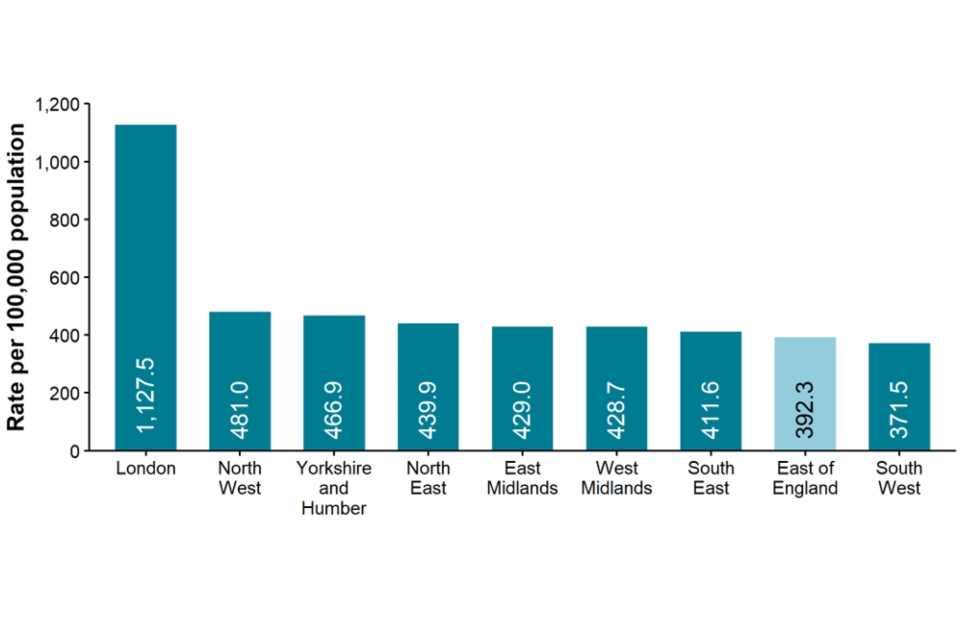
Data sources: GUMCAD STI surveillance system (GUMCAD), CTAD
Figure 1 is a bar chart showing the rate of new STI diagnoses per 100,000 population by UKHSA region of residence in 2021. The East of England had the second lowest rate (392.3 per 100,000) in England. London had the highest rate (1,127.5 per 100,000) and South West had the lowest (371.5 per 100,000).
Figure 2. Number of diagnoses of the 5 main STIs, East of England residents, 2017 to 2021
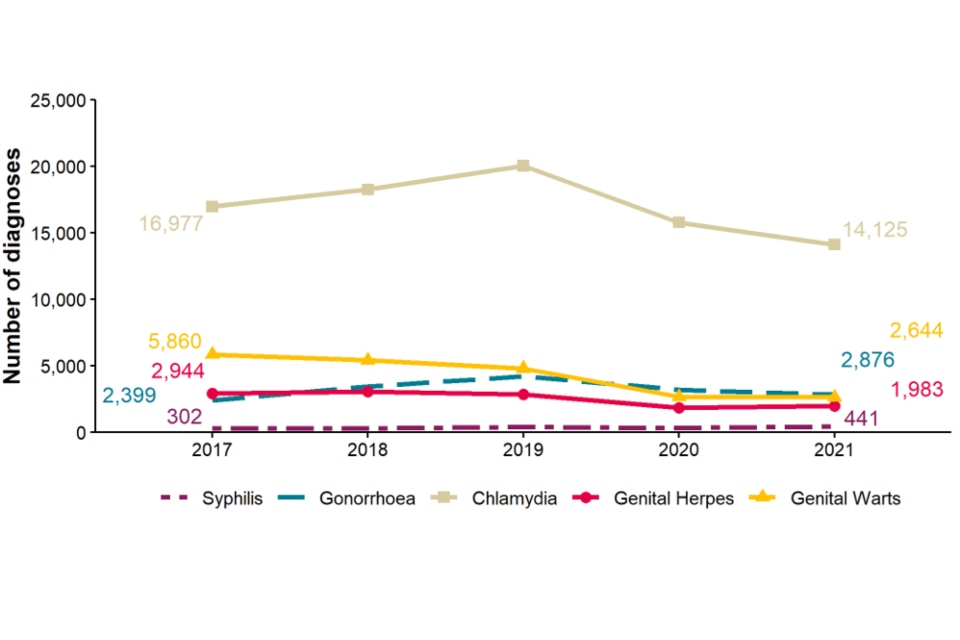
Data sources: GUMCAD, CTAD
[note 1] Any increase in gonorrhoea diagnoses may be due to the increased use of highly sensitive nucleic acid amplification tests (NAATs) and additional screening of extra-genital sites in GBMSM. Any decrease in genital wart diagnoses may be due to a moderately protective effect of HPV-16/18 vaccination. Any increase in genital herpes diagnoses may be due to the use of more sensitive NAATs. Increases or decreases may also reflect changes in testing practices
Figure 2 shows trend lines for the number of diagnoses of the 5 main STIs among East of England residents from 2017 to 2021. The number of diagnoses of chlamydia, genital warts and genital herpes were lower in 2021 compared to 2017. The number of diagnoses of gonorrhoea and syphilis showed an increase in diagnoses from 2017 to 2021.
Figure 3. Diagnosis rates of the 5 main STIs, East of England residents, 2017 to 2021
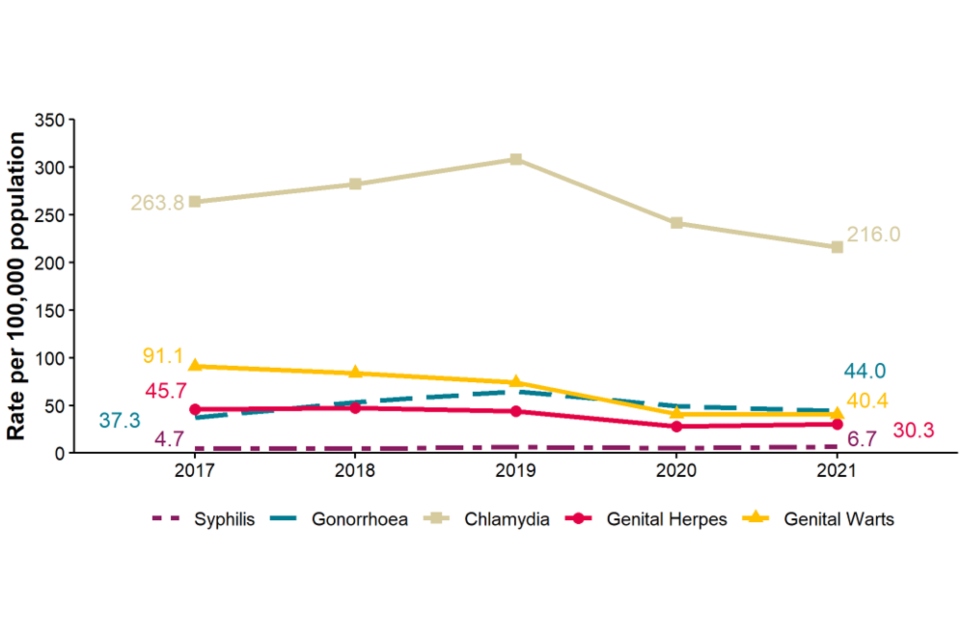
Data sources: GUMCAD, CTAD
See [note 1] above.
Figure 3 shows trend lines for diagnosis rates for the main 5 STIs among East of England residents from 2017 to 2021 per 100,000 population. The highest diagnosis rate in 2021 is for chlamydia (216 per 100,000) and the lowest is syphilis (6.7 per 100,000). Diagnosis rates have increased between 2017 and 2021 for both gonorrhoea and syphilis.
Table 1. Percentage change in new STI diagnoses, East of England residents
| Diagnoses | 2021 | Percentage change from 2017 to 2021 | Percentage change from 2020 to 2021 |
|---|---|---|---|
| New STIs | 25,655 | -26% | -6% |
| Syphilis | 441 | 46% | 30% |
| Gonorrhoea | 2,876 | 20% | -10% |
| Chlamydia | 14,125 | -17% | -11% |
| Genital herpes | 1,983 | -33% | 8% |
| Genital warts | 2,644 | -55% | -1% |
Data sources: GUMCAD, CTAD
See [note 1] above.
Table 1 shows the percentage change in new STI diagnoses in East of England residents. In 2021, 25,655 new STI diagnoses were made in the East of England, which is 6% lower than 2020 and 26% lower than in 2017. Gonorrhoea, chlamydia, and genital warts all decreased from 2020 to 2021. Both genital herpes and syphilis increased between 2020 and 2021.
Figure 4. Rates of new STIs per 100,000 residents by age group (for those aged 15 to 64 years only) and gender in the East of England, 2021
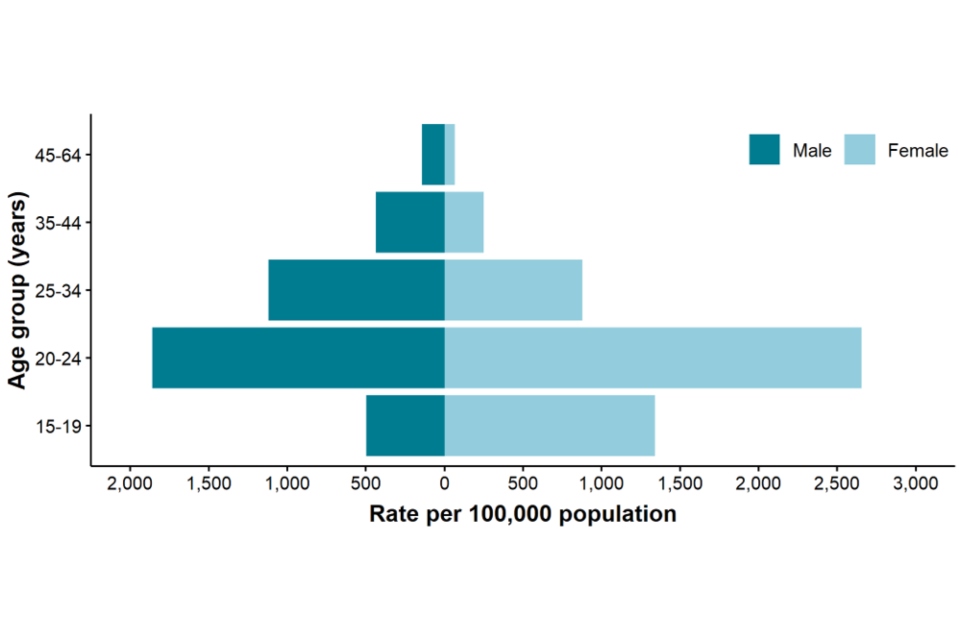
Data sources: GUMCAD, CTAD
Figure 4 is a bar chart showing that the highest rates of new STIs in 2021 were in the group aged 20 to 24 years for both males and females, with a higher rate of diagnosis in females. The lowest rates of new STIs in 2021 were in those aged 45 to 64 years for both males and females.
Figure 5. Rates of gonorrhoea per 100,000 residents by age group [note 2] in the East of England, 2017 to 2021
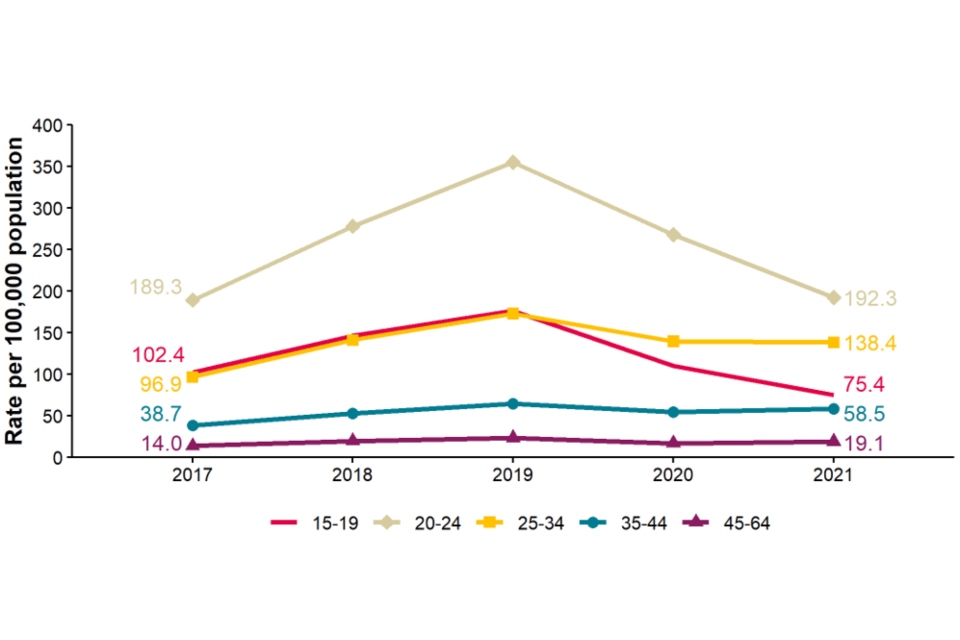
Data source: GUMCAD
[note 2] Age-specific rates are shown for those aged 15 to 64 years only.
Figure 5 shows trend lines for rates of gonorrhoea per 100,000 residents by age group in the East of England from 2017 to 2021. The highest rate of gonorrhoea is in those aged 20 to 24 years and the lowest is in those aged 45 to 64 years. Rates of gonorrhoea have increased in those aged 25 to 34 years, 35 to 44 years, and 45 to 64 years between 2017 and 2021 but have fallen in those aged 15 to 19 years during this time.
Figure 6. Rates of genital warts per 100,000 residents aged 15 to 19 years by gender in the East of England, 2017 to 2021
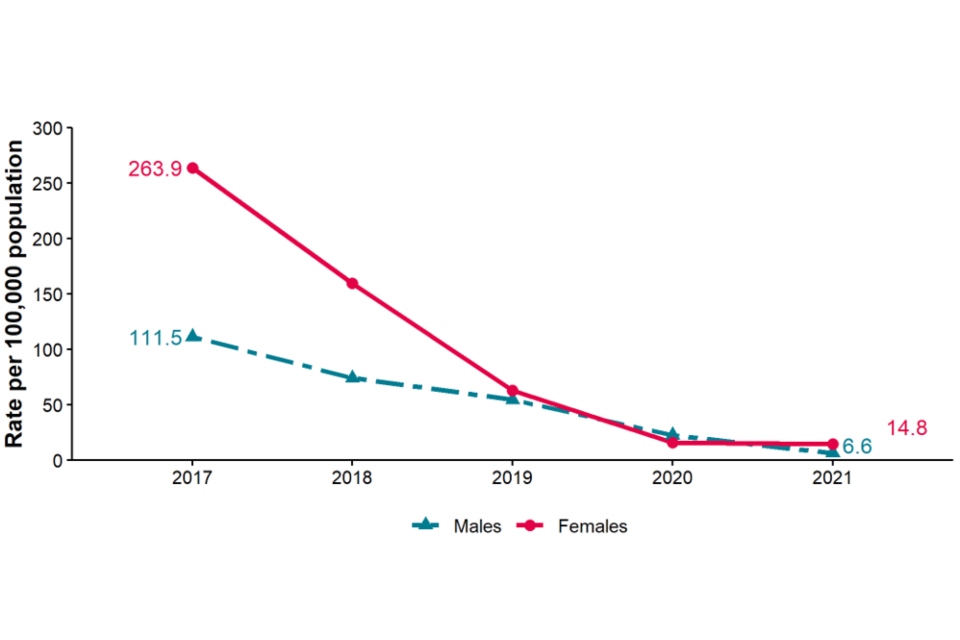
Data source: GUMCAD
Figure 6 shows trend lines for the rate of genital warts per 100,000 residents aged 15-19 years by gender in the East of England between 2017 and 2021. The rate of genital warts decreased from 2017 to 2021 in both males (111.5 per 100,000 to 6.6 per 100,000) and females (263.9 per 100,000 to 14.8 per 100,000).
Figure 7. Rates of new STIs by ethnic group per 100,000 residents in the East of England, 2021
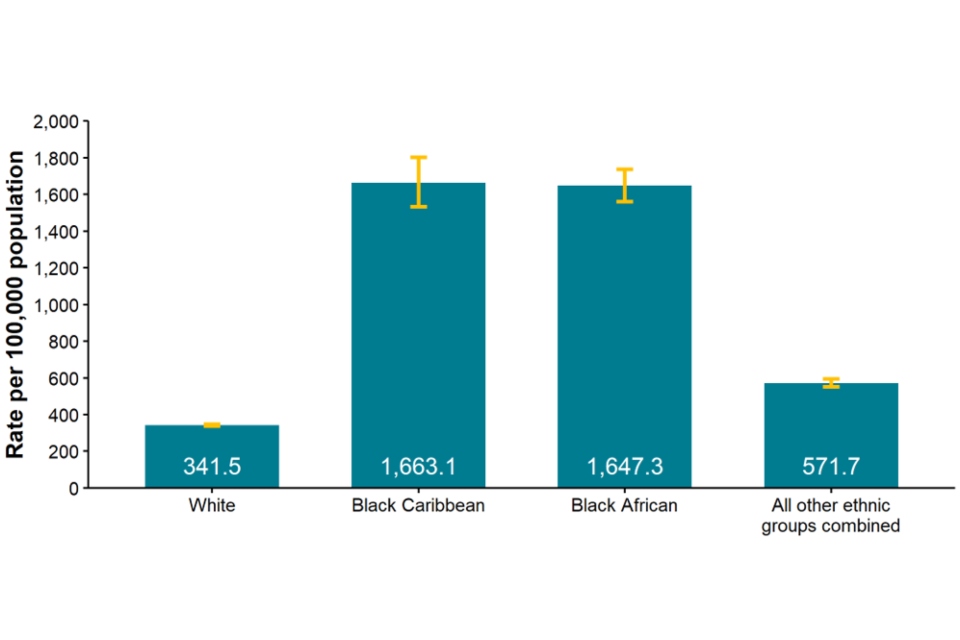
Data sources: GUMCAD, CTAD
Figure 7 is a bar chart showing rates of new STIs by ethnic group per 100,000 in the East of England in 2021. The black Caribbean ethnic group has the highest rate of STIs in 2021 (1663.1 per 100,000) followed by the black African ethnic group (1647.3 per 100,000), all other ethnic groups combined (571.7 per 100,000) and the white ethnic group (341.5 per 100,000).
Table 2. Proportion of East of England residents diagnosed with a new STI by ethnicity, 2021
| Ethnic group | Number | Percentage excluding unknown |
|---|---|---|
| White | 18,812 | 80% |
| Black Caribbean | 601 | 3% |
| Black African | 1,367 | 6% |
| All other ethnic groups combined | 2,672 | 11% |
| Unknown | 2,203 |
Data sources: GUMCAD, CTAD
Table 2 shows the proportion of East of England residents diagnosed with a new STI by ethnicity in 2021. The white ethnic group made up the greatest proportion (80%) and the black Caribbean ethnic group the lowest proportion (3%).
Figure 8. Proportion of East of England residents diagnosed with a new STI by world region of birth [note 3], 2021

Data source: GUMCAD
[note 3] Data on country of birth is not collected by CTAD. All information about world region of birth is based on diagnoses made in specialist and non-specialist services that report to GUMCAD.
Figure 8 is a bar chart showing the proportion of East of England residents diagnosed with a new STI by world region of birth in 2021. The highest proportion was in those who were UK-born (81%) followed by the EU excluding UK (9%).
Figure 9. Diagnoses of the 5 main STIs among GBMSM [note 4], East of England residents, 2017 to 2021
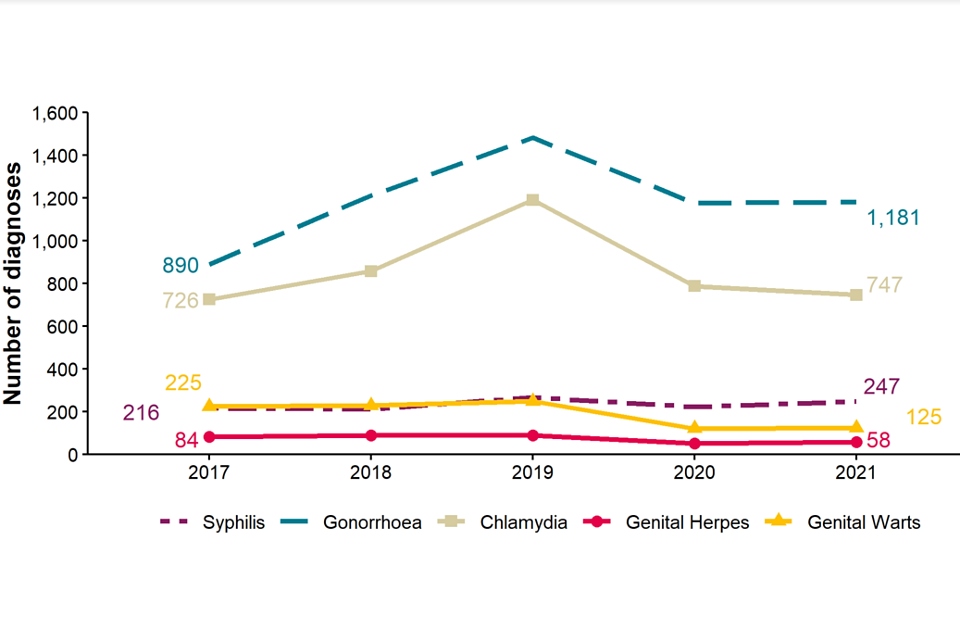
Data source: GUMCAD
[note 4] Data on sexual orientation is not collected by CTAD. All information about GBMSM is based on diagnoses made in specialist and non-specialist services which report to GUMCAD.
GUMCAD started in 2009. Reporting of sexual orientation is less likely to be complete for earlier years, so rises seen may be partly artefactual.
Any increase in gonorrhoea diagnoses may be due to the increased use of highly sensitive nucleic acid amplification tests and additional screening of extra-genital sites in GBMSM. Any decrease in genital wart diagnoses may be due to a moderately protective effect of HPV-16/18 vaccination. Any increase in genital herpes diagnoses may be due to the use of more sensitive NAATs. Any increase or decrease may reflect changes in testing.
Figure 9 shows trend lines for diagnoses of the 5 main STIs among GBMSM in East of England residents from 2017 to 2021. Diagnoses of genital herpes and genital warts declined during this time-period, but diagnoses of gonorrhoea and syphilis increased. Gonorrhoea had the highest number of diagnoses in 2021 (1,181) followed by chlamydia (747).
Table 3. Percentage change in new STI diagnoses in GBMSM residents in the East of England
| Diagnoses | 2021 | Percentage change from 2017 to 2021 | Percentage change from 2020 to 2021 |
|---|---|---|---|
| New STIs | 2,655 | -1% | 1% |
| Syphilis | 247 | 14% | 10% |
| Gonorrhoea | 1,181 | 33% | 0% |
| Chlamydia | 1,125 | 42% | 1% |
| Genital herpes | 58 | -31% | 12% |
| Genital warts | 125 | -44% | 2% |
Data source: GUMCAD
See [note 4] above.
Table 3 shows the percentage change in new STI diagnoses in GBMSM resident in the East of England in 2021. In 2021, 2,655 new STIs were made in GBMSM in the East of England. Genital herpes showed the greatest percentage increase in diagnoses between 2020 and 2021 (12%) followed by syphilis (10%).
Figure 10a. Rate of new STI diagnoses per 100,000 population among East of England residents by upper tier local authority of residence, 2021
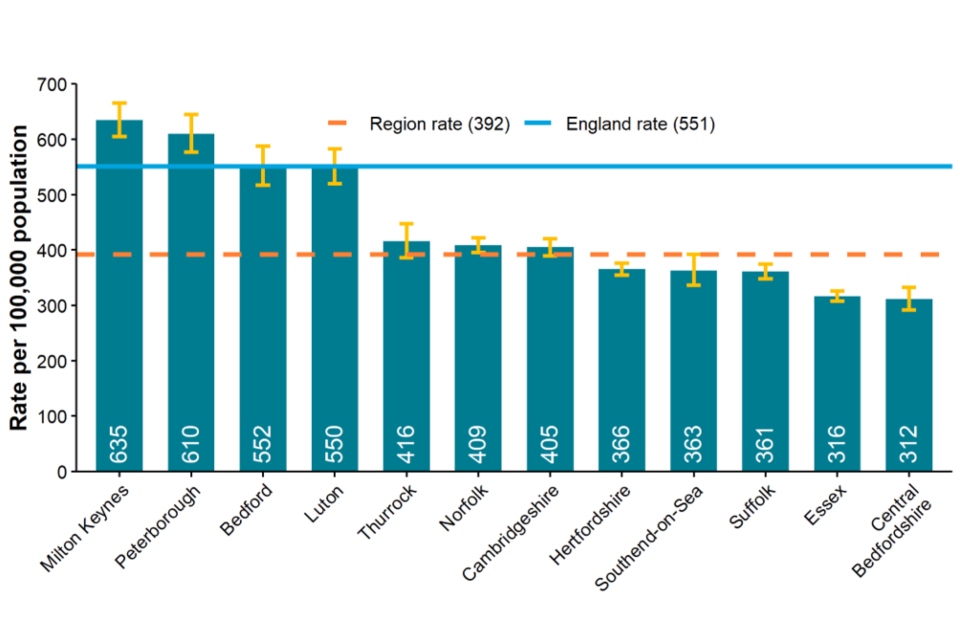
Data sources: GUMCAD, CTAD
Figure 10a is a bar chart showing the rate of new STI diagnoses per 100,000 population among East of England residents by upper tier local authority of residence in 2021. Milton Keynes (635 per 100,000) and Peterborough (610 per 100,000) had the highest rates which were above the England rate of 551 per 100,000. Bedford (552 per 100,000) and Luton (550 per 100,000) had rates that were very similar to the England rate. The lowest rate was in Central Bedfordshire (312 per 100,000).
Figure 10b. Rate of new STI diagnoses (excluding chlamydia diagnoses in people aged 15 to 24 years) per 100,000 population aged 15 to 64 years among East of England residents by upper tier local authority of residence, 2021

Data sources: GUMCAD, CTAD
Figure 10b is a bar chart showing the rate of new STI diagnoses among East of England residents excluding chlamydia diagnoses in people aged 15 to 24 years by upper tier local authority in 2021. In a change from Figure 10a, Peterborough now has the highest rate (700 per 100,000). Peterborough, Milton Keynes, Luton, Bedford, Thurrock, and Norfolk had rates above the East of England rate (431 per 100,000).
Figure 11. Chlamydia detection rate per 100,000 population aged 15 to 24 years in East of England residents by upper tier local authority of residence, 2021
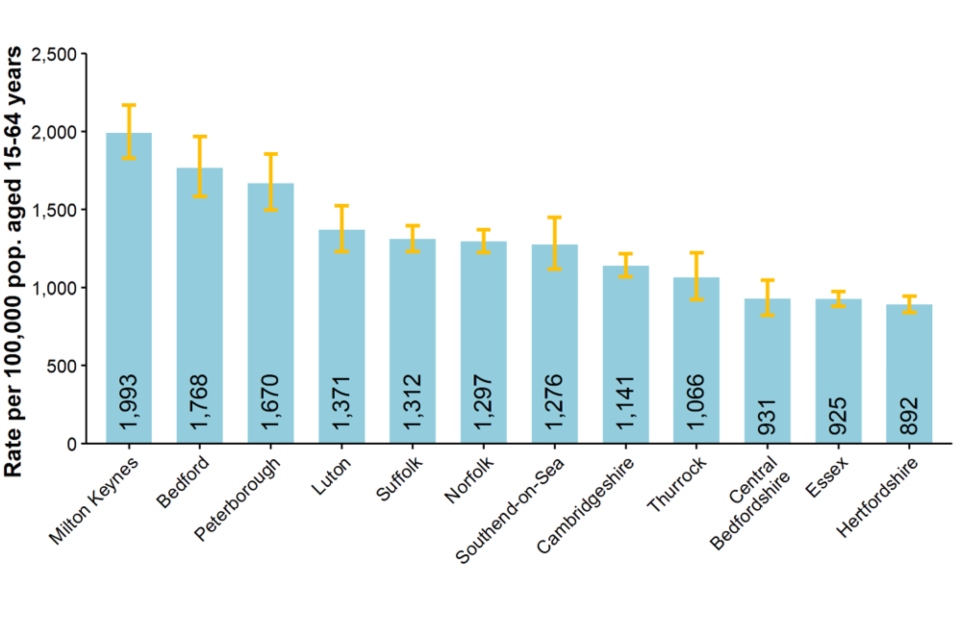
Data sources: GUMCAD, CTAD
Figure 11 is a bar chart showing the chlamydia detection rate per 100,000 population aged 15 to 24 years in East of England residents by upper tier local authority of residence in 2021. The highest rate was in Milton Keynes (1,993 per 100,000) followed by Bedford (1,768 per 100,000). The lowest rate was in Hertfordshire (892 per 100,000).
Figure 12. Rate of gonorrhoea diagnoses per 100,000 population in East of England residents by upper tier local authority of residence, 2021
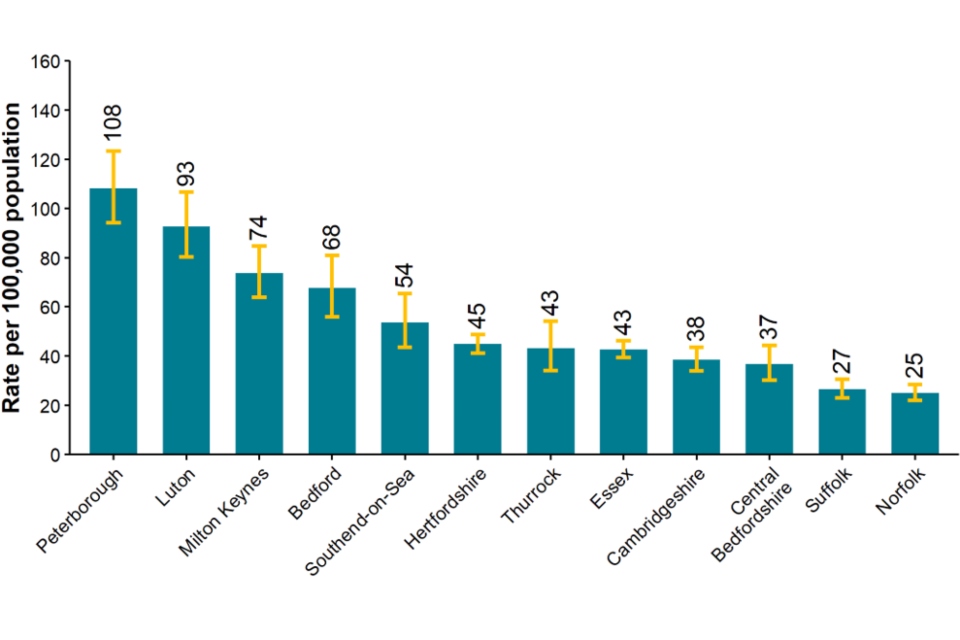
Data source: GUMCAD
Figure 12 is a bar chart showing the rate of gonorrhoea diagnoses per 100,000 population in East of England residents by upper tier local authority of residence in 2021. Peterborough had the highest rate (108 per 100,000) followed by Luton (93 per 100,000) and Milton Keynes (74 per 100,000). The lowest rate is in Norfolk (25 per 100,000).
Figure 13. Map of new STI rates per 100,000 residents by upper tier local authority in the East of England, 2021
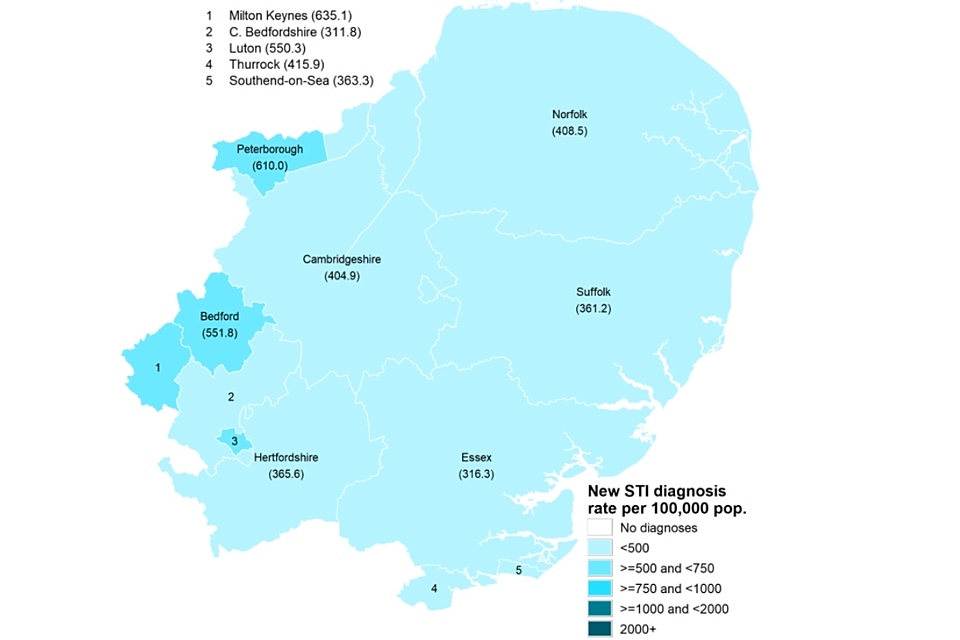
Data sources: GUMCAD, CTAD. Map contains Ordnance Survey data © Crown copyright and database right 2021, and National Statistics data © Crown copyright and database right 2021
Figure 13 is a map of of all East of England upper tier local authorities showing new STI rates per 100,000 residents in 2021. Four local authorities (Milton Keynes, Peterborough, Bedford, and Luton) had rates within the range 500 and 749 per 100,000. All other upper tier local authorities in the East of England had rates below 500 per 100,000.
Figure 14. STI testing rate (excluding chlamydia in those aged under 25 years) per 100,000 population in East of England residents aged 15 to 64 years, 2017 to 2021
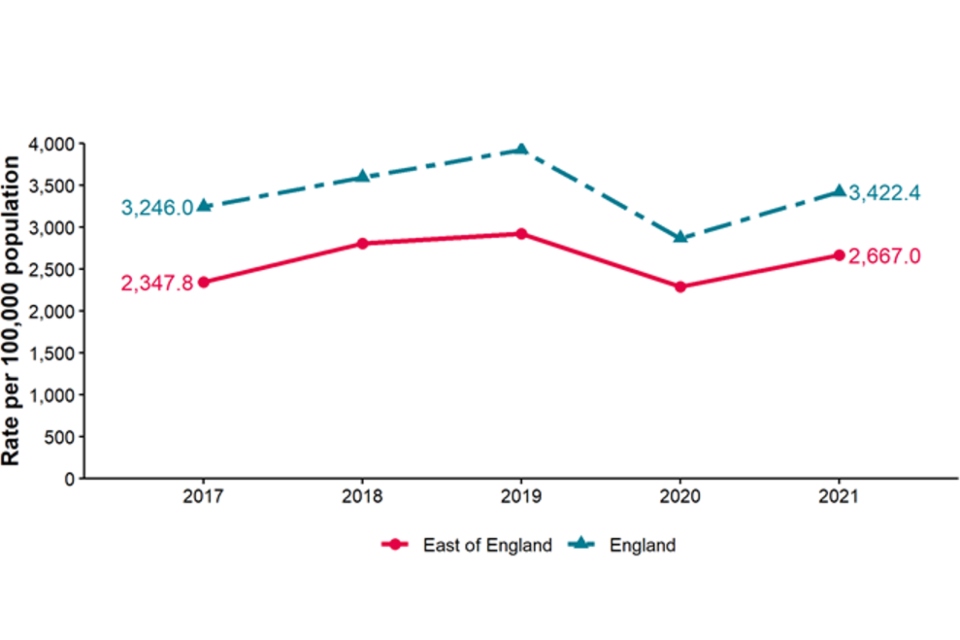
Data sources: GUMCAD, CTAD
Figure 14 shows trend lines for STI testing rate (excluding chlamydia in those aged under 25 years) per 100,000 in East of England residents aged 15 to 64 years between 2017 and 2021. The East of England testing rate has consistently been below the England rate. The testing rate in the East of England was higher in 2021 (2,667.0 per 100,000) compared to 2017 (2,347.8 per 100,000).
Figure 15. STI testing positivity rate [note 5] (excluding chlamydia in those aged under 25 years) in East of England residents, 2017 to 2021
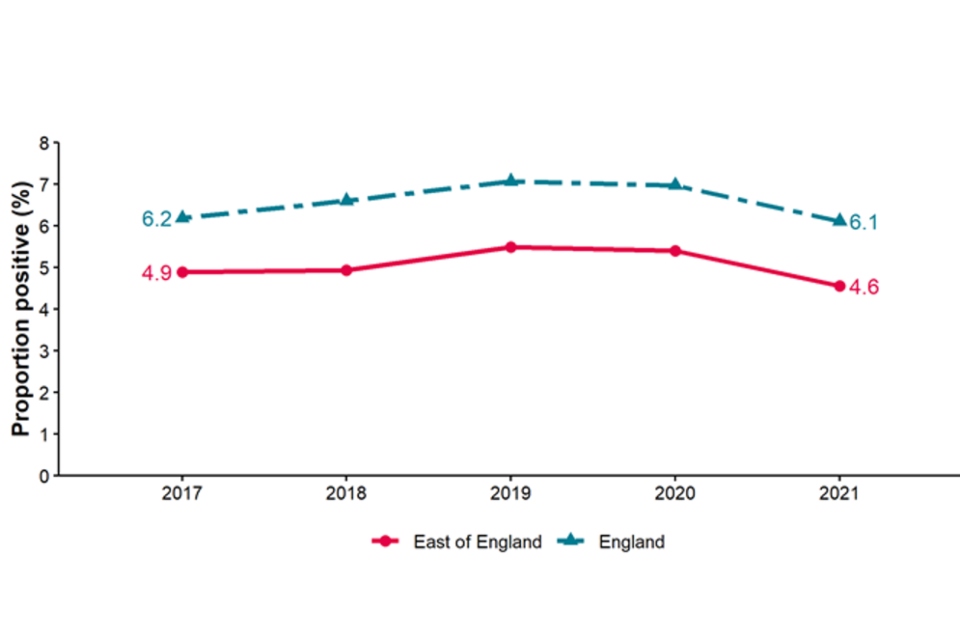
Data sources: GUMCAD, CTAD
[note 5] The numerator for the STI testing positivity rate now only includes infections which are also included in the denominator. These are: chlamydia (excluding diagnoses in those aged under 25 years), gonorrhoea, syphilis and HIV. Up to 2018 (data for 2017) it included all new STIs.
Figure 15 shows trend lines for STI testing positivity rate (excluding chlamydia in those aged under 25 years) in East of England residents between 2017 and 2021. The East of England testing positivity has consistently been below the England rate. The testing positivity in the East of England was lower in 2021 (4.6%) compared with 2017 (4.9%).
Table 4. Number of diagnoses of new STIs by UKHSA region of residence, data source and data subset 2021
| UKHSA region of residence | GUMCAD | CTAD [note 7] | Total | |
|---|---|---|---|---|
| Specialist SHSs | Non-specialist SHSs [note 6] | |||
| East Midlands | 10,622 | 6,275 | 3,974 | 20,871 |
| East of England | 15,809 | 4,238 | 5,608 | 25,655 |
| London | 69,545 | 8,162 | 23,792 | 101,499 |
| North East | 7,495 | 1,580 | 2,718 | 11,793 |
| North West | 23,693 | 3,789 | 7,954 | 35,436 |
| South East | 26,578 | 1,960 | 8,287 | 36,825 |
| South West | 13,797 | 2,444 | 4,782 | 21,023 |
| West Midlands | 16,890 | 3,867 | 4,804 | 25,561 |
| Yorkshire and Humber | 16,031 | 2,050 | 7,724 | 25,805 |
Data sources: GUMCAD, CTAD
[note 6] Diagnoses from enhanced GPs reporting to GUMCAD are included in the ‘Non-specialist SHSs’ total.
[note 7] Including site type 12 chlamydia from GUMCAD.
Table 4 shows the number of diagnoses of new STIs by UKHSA region of residence in 2021. The highest total number of diagnoses was in London (101,499) and the lowest in the North East (11,793). In the East of England there was a total of 25,655 diagnoses. The majority were from specialist sexual health services (15,809) followed by CTAD (5,608) and non-specialist sexual health services (4,238).
Table 5. Number of diagnoses of the 5 main STIs in the East of England by STI, data source and data subset 2021
| 5 main STIs | GUMCAD | CTAD [note 9] | Total | |
|---|---|---|---|---|
| Specialist SHSs | Non-specialist SHSs [note 8] | |||
| Syphilis | 440 | 1 | 441 | |
| Gonorrhoea | 1,973 | 903 | 2,876 | |
| Chlamydia | 5,254 | 3,263 | 5,608 | 14,125 |
| Genital herpes | 1,978 | 5 | 1,983 | |
| Genital warts | 2,621 | 23 | 2,644 |
Data sources: GUMCAD, CTAD
[note 8] Diagnoses from enhanced GPs reporting to GUMCAD are included in the ‘Non-specialist SHSs’ total.
[note 9] Including site type 12 chlamydia from GUMCAD.
Table 5 shows the number of diagnoses of the 5 main STIs in the East of England by source of diagnoses in 2021. Most diagnoses came from specialist SHSs for syphilis, gonorrhoea, genital herpes, and genital warts. CTAD is a surveillance system for chlamydia only and most diagnoses for chlamydia came from this system (5,608), closely followed by specialist SHSs (5,254) and then non-specialist SHSs (3,263).
Figure 16. Consultations by consultation medium: East of England residents, 2017 to 2021

Data sources: GUMCAD, CTAD
Figure 16 is a bar chart showing the number of consultations in East of England residents attending SHSs (levels 2 or 3) over the period 2017 to 2021 by consultation type.
Between 2017 and 2019, most consultations were performed face to face, with a small number of online and telephone consultations. During 2020 (first year of the COVID-19 pandemic) face-to-face consultations decreased and those online and via telephone increased. In 2021, face-to-face consultations continued to decrease now accounting for just under half of all consultations.
Information on data sources
Find more information on local sexual health data sources on GOV.UK.
These figures are based on data from the GUMCAD and CTAD surveillance systems published on 4 October 2022 (data to the end of calendar year 2021).
GUMCAD surveillance system
This disaggregate reporting system collects information about attendances and diagnoses at specialist (level 3) and non-specialist (level 2) SHSs. Information about the patient’s area of residence is collected along with demographic data and other variables. GUMCAD superseded the earlier KC60 system and can provide data from 2009 onwards. GUMCAD is the main source of data for this report.
Due to limits on how much personally identifiable information SHCs are able to share, it is not possible to deduplicate between different clinics. There is a possibility that some patients may be counted more than once if they are diagnosed with the same infection (for infection specific analyses) or a new STI of any type (for new STI analyses) at different clinics during the same calendar year.
CTAD surveillance system
CTAD collects data on all NHS and local authority or NHS-commissioned chlamydia testing carried out in England. CTAD is comprised of all chlamydia (NAATs) tests for all ages (with the exception of conjunctival samples), from all venues and for all reasons. CTAD enables unified, comprehensive reporting of all chlamydia data, to effectively monitor the impact of the NCSP through estimation of the coverage of population screening, proportion of all tests that are positive and detection rates.
For services which report to GUMCAD and for which CTAD does not receive data on the patient’s area of residence (for example, SHSs), information about chlamydia diagnoses is sourced from GUMCAD data.
New STIs
New STI diagnoses comprise diagnoses of the following:
- chancroid
- lymphogranuloma venereum (LGV)
- donovanosis
- chlamydia
- gonorrhoea
- genital herpes (first episode)
- HIV (acute and AIDS defining)
- molluscum contagiosum
- non-specific genital infection (NSGI)
- non-specific pelvic inflammatory disease (PID) and epididymitis
- chlamydial PID and epididymitis (presented in chlamydia total)
- gonococcal PID and epididymitis (presented in gonorrhoea total)
- scabies
- pediculosis pubis
- syphilis (primary, secondary and early latent)
- trichomoniasis and genital warts (first episode)
- mycoplasma genitalium
- Shigella
Calculations
Confidence Intervals were calculated using Byar’s method.
Office for National Statistic (ONS) mid-year population estimates for 2020 were used as a denominator for rates for 2021. ONS estimates for 2011 were used as a denominator for rates for 2021 as these reports were published before the estimates for 2021 (the first produced since 2011) were published.
Further information
As of 2020, all analyses for this report include data from non-specialist (level 2) SHSs and enhanced GP services as well as specialist (level 3) SHSs.
For further information, access the online Sexual and Reproductive Health Profiles.
Find more information on local sexual health data sources on GOV.UK.
Local authorities have access to the Summary Profile of Local Authority Sexual Health (SPLASH) Reports (accessible from the Sexual and Reproductive Health Profiles) and the SPLASH supplement reports via the HIV and STI Data exchange.
For an Annual Epidemiological Spotlight on HIV in the East of England, contact eoe.stihiv@ukhsa.gov.uk
About the Field Service
The Field Service was established in 2018 as a national service comprising geographically dispersed multi-disciplinary teams integrating expertise in Field Epidemiology, Real-time Syndromic Surveillance, Public Health Microbiology and Food, Water and Environmental Microbiology to strengthen the surveillance, intelligence and response functions of UKHSA.
You can contact your local Field Service team at eoe.stihiv@ukhsa.gov.uk
If you have any comments or feedback regarding this report or the Field Service, contact eoe.stihiv@ukhsa.gov.uk
Acknowledgements
We would like to thank:
- local SHSs for supplying the SHS data
- local laboratories for supplying the CTAD data
- the UKHSA Blood Safety, Hepatitis, STI and HIV Division for collection, analysis and distribution of data
References
1. Mitchell KR, Shimonovich M, Bosó Pérez R, Dema E, Clifton S, Riddell J and others. ‘Initial Impacts of COVID-19 on sex life and relationship quality in steady relationships in Britain: Findings from a large, quasi-representative Survey (Natsal-COVID)’ The Journal of Sex Research March 2022: pages 1 to 12 (accessed 11 August 2022)
2. Howarth A, Saunders J, Reid D, Kelly I, Wayal S, Weatherburn P, Hughes G, and Mercer C. ‘Stay at home … Exploring the impact of the COVID-19 public health response on sexual behaviour and health service use among men who have sex with men: findings from a large online survey in the United Kingdom’ Sexually Transmitted Infections July 2022: pages 346 to 352 (accessed 11 August 2022)
3. Dema E, Gibbs J, Clifton S and others. ‘Initial impacts of COVID-19 on sexual and reproductive health service use and unmet need in Britain: findings from a large, quasirepresentative survey (Natsal-COVID)’ The Lancet Public Health January 2022: volume 7, pages e36 to 47
4. Sonnenberg P, Menezes D, Freeman L and others. ‘Intimate physical contact between people from different households during the COVID-19 pandemic: a mixed-methods study from a large, quasi-representative survey (Natsal-Covid)’. British Medical Journal Open February 2022: volume 12, issue 2 (accessed 11 August 2022)
5. Ratna N, Dema E, Conolly A and others. ‘O16 Ethnic variations in sexual risk behaviour, sexual health service use and unmet need during the first year of the COVID-19 pandemic: an analysis of population-based survey and surveillance data’. Sexually Transmitted Infections. 2022, volume 98: pages A8 to A9 (accessed 11 August 2022)
6. Sumray K, Lloyd KC, Estcourt CS, Burns F and Gibbs J. ‘Access to, usage and clinical outcomes of, online postal sexually transmitted infection services: a scoping review’ Sexually Transmitted Infections June 2022: pages 1 to 8 (accessed 11 August 2022)
